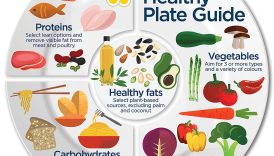Happy and Healthy Living: Tips for a Balanced Life

Introduction to Happy and Healthy Living
Importance of Balance in Life
Finding a harmonious balance in life is fundamental to achieving happiness and well-being. It’s about recognizing the interplay between various aspects of our existence—such as work, relationships, health, and personal interests. When one area overshadows the others, stress and dissatisfaction can creep in, leading to a decline in quality of life. For instance, someone may work tirelessly to climb the career ladder, only to realize they’ve neglected their health or relationships.
- Happy and Healthy Living: Tips for a Balanced Life
- Introduction to Happy and Healthy Living
- Importance of Balance in Life
- Benefits of a Balanced Lifestyle
- Physical Health Tips
- Regular Exercise
- Healthy Eating Habits
- Mental Well-being Strategies
- Stress Management Techniques
- Prioritizing Self-care
- Social Connections and Relationships
- Building Supportive Relationships
- Communicating Effectively
- Emotional Well-being Practices
- Practicing Gratitude
- Cultivating Positivity
- Work-life Balance
- Time Management Tips
- Setting Boundaries
- Mindfulness and Meditation
- Mindful Living Tips
- Meditation Techniques
- Quality Sleep Habits
- Creating a Relaxing Bedtime Routine
- Importance of Sleep Hygiene
- Hobbies and Recreation
- Finding Joy in Leisure Activities
- Balancing Work and Play
- Financial Wellness Tips
- Budgeting and Saving Strategies
- Avoiding Financial Stress
- Personal Development and Growth
- Setting Goals and Intentions
- Continuous Learning and Improvement
- XII. Environmental Health Practices
- Sustainable Living Tips
- Connecting with Nature
- XIII. Maintaining a Positive Outlook
- Positive Affirmations
- Overcoming Negativity
- XIV. Seeking Professional Help and Support
- Therapy and Counseling Options
- Community Resources
- XV. Conclusion: Sustaining a Balanced and Happy Lifestyle
Benefits of a Balanced Lifestyle
Embracing a balanced lifestyle comes with a plethora of advantages:
- Reduced Stress: Managing life’s demands helps minimize anxiety.
- Improved Health: Investing time in fitness and nutrition enhances physical well-being.
- Enhanced Relationships: Nurturing personal connections fosters support and joy.
- Greater Fulfillment: Engaging in hobbies and passions fuels creativity and satisfaction.
Incorporating balance brings out the best in individuals, enabling them to navigate life’s challenges with resilience and positivity.
Physical Health Tips
Regular Exercise
Incorporating regular exercise into your routine is essential for maintaining physical health. It doesn’t have to mean lengthy gym sessions; even short, daily activities can make a significant difference. For example, walking or cycling to work, or even taking the stairs instead of the elevator, can boost your energy and mood remarkably. Here are some effective ways to stay active:
- Set achievable goals: Start with 15-20 minutes a day to build consistency.
- Try different activities: Explore running, swimming, or yoga to find what you enjoy.
- Join a class or group: Social workouts can keep you motivated and accountable.
Healthy Eating Habits
Alongside exercise, healthy eating habits play a crucial role in overall wellness. It’s about making conscious choices that nourish your body. For instance, substituting processed snacks with fruits or nuts can curb cravings and enhance energy levels. Here are some tips to improve your diet:
- Plan your meals: Take time each week to prepare balanced meals.
- Stay hydrated: Aim for at least 8 glasses of water daily.
- Mindful eating: Focus on your food during meals to enjoy it more and avoid overeating.
By prioritizing exercise and healthy eating, individuals can cultivate a strong foundation for a vibrant life.
Mental Well-being Strategies
Stress Management Techniques
Managing stress is crucial for maintaining mental health. Everyday life can be overwhelming, but implementing effective stress management techniques can pave the way for greater calm and clarity. Techniques such as deep breathing or progressive muscle relaxation can quickly ground you when tension builds. Consider these strategies:
- Time management: Prioritize tasks to avoid last-minute stress.
- Physical activity: Exercise releases endorphins that uplift mood.
- Mindfulness practices: Spend a few minutes meditating or journaling to reflect on your feelings.
Prioritizing Self-care
Beyond stress management, prioritizing self-care is vital for mental well-being. It’s more than occasional pampering; it’s about incorporating daily habits that nurture your mind and spirit. For example, dedicating time to hobbies or simply engaging in quiet reflection can recharge your energy. A few self-care ideas include:
- Regular breaks: Step away from work to clear your mind.
- Setting boundaries: Learn to say no to protect your time.
- Engaging in activities you love: Whether it’s painting or hiking, do what makes you happy.
By actively managing stress and embracing self-care, individuals can cultivate a resilient mindset that enhances overall mental wellness.
Social Connections and Relationships
Building Supportive Relationships
Strong, supportive relationships are fundamental to emotional well-being. They provide a sense of belonging and security. Take a moment to reflect: think about the friends or family members who uplift you during tough times. Building more of these connections can be as simple as reaching out for lunch with a friend or joining community groups that interest you. Here are some ways to foster supportive relationships:
- Be present: Show genuine interest and actively listen to others.
- Offer help: Supporting your loved ones strengthens the bond.
- Participate in social activities: Engage in group activities to meet new people.
Communicating Effectively
Effective communication is key to maintaining healthy relationships. It involves not only expressing your thoughts and feelings clearly but also being open to hearing others. Using “I” statements, such as “I feel,” can help convey emotions without placing blame, promoting open dialogue. To enhance your communication skills, try:
- Practicing active listening: Focus on understanding rather than responding.
- Being mindful of non-verbal cues: Body language and tone also convey messages.
- Having regular check-ins: Discuss each other’s feelings and experiences.
By building supportive relationships and honing communication skills, individuals can create a nurturing social environment that contributes significantly to their overall happiness and well-being.
Emotional Well-being Practices
Practicing Gratitude
Practicing gratitude can transform your emotional landscape by shifting focus from what’s lacking to appreciating what you have. Taking a moment each day to acknowledge the positives can dramatically enhance your mood. For instance, maintaining a gratitude journal where you jot down three things you’re thankful for can foster a more optimistic outlook. Consider these gratitude practices:
- Daily reflections: Spend a few minutes each day thinking about your blessings.
- Thank-you notes: Express gratitude to friends or colleagues to strengthen bonds.
- Gratitude jars: Fill a jar with notes of appreciation and read them at the year’s end.
Cultivating Positivity
Alongside gratitude, cultivating positivity is essential for emotional well-being. Surrounding yourself with uplifting people and engaging in joyful activities can boost your resilience. For example, I started attending a weekly trivia night with friends, and it has become a delightful tradition that lifts my spirits. Here are some strategies to foster a positive mindset:
- Practice positive affirmations: Repeat encouraging statements to combat negative thoughts.
- Limit negative influences: Be mindful of the media you consume and the company you keep.
- Engage in uplifting activities: Invest time in hobbies that bring you joy.
By incorporating gratitude and cultivating positivity, individuals can enhance their emotional well-being, paving the way for a happier and more fulfilling life.
Work-life Balance
Time Management Tips
Achieving a healthy work-life balance often hinges on effective time management. By organizing tasks and setting priorities, individuals can create more space for personal time. Personally, I’ve found that using planning apps helps me allocate time realistically, ensuring I’m not overwhelmed. Here are some time management tips:
- Prioritize tasks: Use the Eisenhower Matrix to distinguish between urgent and important tasks.
- Set specific time blocks: Dedicate focused periods for each task to enhance productivity.
- Limit distractions: Identify what distracts you and create strategies to minimize interruptions.
Setting Boundaries
In addition to managing time, setting boundaries is crucial for maintaining a healthy work-life balance. It’s important to clearly define when work ends and personal life begins. For instance, I’ve made it a habit to turn off work-related notifications after a certain time each evening. To effectively set boundaries, consider:
- Communicating your limits: Let colleagues and supervisors know your availability.
- Designating workspace: Create a defined area at home dedicated solely to work.
- Learning to say no: Protect your time by declining commitments that don’t align with your priorities.
By adopting time management strategies and establishing boundaries, individuals can cultivate a more balanced life that honors both their professional and personal needs.
Mindfulness and Meditation
Mindful Living Tips
Incorporating mindfulness into daily life can profoundly enhance your awareness and appreciation of the present moment. For me, practicing mindfulness transformed my occasional anxiety into a more grounded sense of peace. Simple adjustments to your routine can foster this state of mind. Here are some mindful living tips:
- Start your day with intention: Spend a few moments each morning reflecting on your goals.
- Practice conscious eating: Focus on the flavors and textures of your food rather than multitasking during meals.
- Engage all senses: Take time to notice your surroundings through sights, sounds, and scents.
Meditation Techniques
Complementing mindful living, meditation is a powerful practice for cultivating inner calm. My journey with meditation began with just five minutes a day, and over time, it significantly improved my mental clarity. Some effective meditation techniques include:
- Guided meditations: Use apps or online resources to help you get started.
- Breath awareness: Focus solely on your breath to anchor your thoughts.
- Walking meditation: Mindfully walk while paying attention to each step, blending movement with meditation.
By integrating mindfulness and meditation into your daily routine, you can foster a deeper awareness and a more serene mindset, ultimately enhancing overall well-being.
Quality Sleep Habits
Creating a Relaxing Bedtime Routine
Establishing a relaxing bedtime routine is essential for quality sleep. After busy days, I find that unwinding with consistent rituals helps signal to my body that it’s time to rest. Simple evening practices can make a significant difference. Consider these tips for creating an effective bedtime routine:
- Set a consistent sleep schedule: Go to bed and wake up at the same time daily.
- Limit screen time: Aim to turn off electronic devices at least an hour before bed.
- Incorporate calming activities: Try reading, gentle yoga, or warm baths to relax.
Importance of Sleep Hygiene
Sleep hygiene refers to habits that cultivate a conducive sleep environment. Poor sleep hygiene can lead to restless nights and fatigue. I’ve learned that small changes in my sleep environment greatly enhance my sleep quality. Here are key sleep hygiene practices to adopt:
- Create a comfortable sleep environment: Ensure your mattress and pillows are supportive.
- Control room temperature: Keep your bedroom cool to promote restful sleep.
- Limit caffeine and heavy meals: Avoid stimulation in the hours leading up to bedtime.
By prioritizing a relaxing bedtime routine and maintaining good sleep hygiene, individuals can significantly improve their sleep quality, leading to better overall health and well-being.
Hobbies and Recreation
Finding Joy in Leisure Activities
Engaging in hobbies and recreational activities plays a pivotal role in maintaining a balanced life. These moments of joy allow us to unwind and express ourselves creatively. For me, rediscovering my love for painting provided an incredible outlet for stress relief. Here are some ways to find joy in leisure activities:
- Explore new interests: Try out different hobbies like gardening, photography, or cooking.
- Connect with others: Join clubs or classes that align with your interests to meet like-minded people.
- Set aside dedicated time: Schedule regular leisure time in your calendar to ensure you prioritize your hobbies.
Balancing Work and Play
While work responsibilities are important, balancing them with play is essential for overall happiness. Too often, individuals find themselves caught in the grind, neglecting personal joy. I’ve found that designing my week with time allocated not just for work but also for fun has drastically improved my mood and productivity. To maintain this balance, consider:
- Establishing clear work hours: Stay committed to your working hours and leave work behind at the end of the day.
- Incorporating breaks during work: Short breaks can rejuvenate your mind and enhance focus.
- Making leisure a priority: Treat your hobbies with the same importance as work commitments.
By prioritizing leisure activities and maintaining a harmonious balance between work and play, individuals can enrich their lives, foster creativity, and enhance overall well-being.
Financial Wellness Tips
Budgeting and Saving Strategies
Achieving financial wellness begins with effective budgeting and saving strategies. Personally, I found that creating a detailed budget not only kept my spending in check but also highlighted areas where I could save. Here are some budgeting and saving strategies to consider:
- Track your expenses: Use apps or spreadsheets to monitor where your money goes.
- Set specific savings goals: Whether it’s for a vacation or an emergency fund, having clear objectives makes saving more achievable.
- Automate your savings: Set up automatic transfers to your savings account to ensure you save regularly.
Avoiding Financial Stress
While budgeting is key, avoiding financial stress is equally vital. Managing finances can often feel overwhelming, but a proactive approach can help alleviate anxiety. I’ve found that periodic financial check-ins serve as an effective way to stay on top of my expenses. Here are some tips to avoid financial stress:
- Review your budget regularly: Adjust your budget as needed to reflect changing circumstances.
- Build an emergency fund: Aim for three to six months’ worth of living expenses to cushion unexpected events.
- Practice mindful spending: Before making a purchase, ask yourself if it aligns with your values and goals.
By implementing smart budgeting practices and strategies to alleviate financial stress, individuals can foster a sense of security and peace of mind, contributing to overall financial wellness and stability.
Personal Development and Growth
Setting Goals and Intentions
Personal development is a transformative journey that begins with setting clear goals and intentions. This practice has been invaluable for me, providing direction and motivation in my life. By articulating specific, measurable goals—whether fitness milestones or career aspirations—individuals can stay focused on their objectives. Here are some tips for effective goal setting:
- Use the SMART criteria: Ensure your goals are Specific, Measurable, Achievable, Relevant, and Time-bound.
- Visualize success: Create a vision board to keep your goals in sight and in mind.
- Break them down: Divide larger goals into manageable tasks to avoid feeling overwhelmed.
Continuous Learning and Improvement
Alongside goal setting, embracing continuous learning is essential for personal growth. I’ve discovered that making time for learning—be it through reading, online courses, or workshops—enriches my life and broadens my perspective. To foster a mindset of continuous improvement, consider:
- Setting a reading goal: Aim to read a certain number of books each month to expand your knowledge.
- Seeking feedback: Ask for constructive criticism from peers to identify areas for growth.
- Embracing challenges: Step outside your comfort zone to learn new skills and gain confidence.
By setting intentional goals and committing to lifelong learning, individuals can pave the way for personal development and a fulfilling life journey.
XII. Environmental Health Practices
Sustainable Living Tips
Adopting sustainable living practices not only benefits the environment but can also enhance personal well-being. Over the past few years, I’ve made small changes in my lifestyle that have had a significant positive impact. Simple adjustments, like reducing plastic use and shopping locally, can lead to a more sustainable life. Here are some tips for sustainable living:
- Reduce waste: Embrace a zero-waste approach by using reusable bags, containers, and straws.
- Choose eco-friendly products: Opt for biodegradable and non-toxic cleaning and personal care items.
- Support local businesses: Shopping at farmer’s markets not only reduces your carbon footprint but also strengthens community ties.
Connecting with Nature
Connecting with nature is essential for both environmental health and personal well-being. Spending time outdoors nourishes the body and soul. I find that my best ideas often come while hiking or simply taking a stroll in my local park. Consider these ways to deepen your connection with nature:
- Plan regular outdoor activities: Go hiking, biking, or simply take a walk in your neighborhood.
- Start a garden: Whether it’s a small herb garden on your windowsill or a backyard veggie patch, gardening fosters a sense of responsibility towards the planet.
- Practice mindfulness in nature: Engage in mindful walking, paying attention to the sights, sounds, and smells around you.
By embracing sustainable living and fostering a connection with nature, individuals can enhance their personal health while contributing positively to the environment.
XIII. Maintaining a Positive Outlook
Positive Affirmations
Maintaining a positive outlook can significantly transform one’s perspective on life, and positive affirmations are a powerful tool in this practice. I started my day with simple affirmations like “I am capable” and “Today will be a good day,” and I was amazed at how it shifted my mindset. Here are some tips for creating effective positive affirmations:
- Be specific: Tailor your affirmations to address your personal goals (e.g., “I am improving my public speaking skills”).
- Use the present tense: Phrase your affirmations as if they are already true.
- Repeat daily: Integrate affirmations into your morning routine to reinforce positivity.
Overcoming Negativity
While positivity is vital, overcoming negativity is equally important for maintaining mental well-being. Life’s challenges can sometimes cloud our judgment and outlook. I’ve found that recognizing negative thoughts as they arise helps me reframe them more constructively. To combat negativity, consider these strategies:
- Challenge negative thoughts: Ask yourself if there’s evidence to support those thoughts.
- Surround yourself with positivity: Engage with uplifting people and content that inspires you.
- Practice gratitude: Regularly acknowledging what you’re thankful for can shift focus from the negative to the positive.
By incorporating positive affirmations and actively working to overcome negativity, individuals can cultivate a more optimistic outlook on life, contributing significantly to overall happiness and well-being.
XIV. Seeking Professional Help and Support
Therapy and Counseling Options
Sometimes, maintaining a positive outlook and managing emotional well-being requires professional help, and therapy can be a transformative experience. I remember my first counseling session, which felt daunting yet enlightening, as it offered me new perspectives on my challenges. When considering therapy options, keep these points in mind:
- Identify your needs: Different therapists specialize in various areas, so seek one who aligns with your specific concerns.
- Explore modalities: Options vary from cognitive-behavioral therapy (CBT) to mindfulness-based approaches; find what resonates with you.
- Establish a connection: It’s vital to feel comfortable with your therapist for effective healing.
Community Resources
In addition to therapy, community resources provide vital support for mental health. Many towns offer workshops, support groups, and hotlines that can be incredibly beneficial. For instance, I found a local support group that created a safe space to share experiences and learn from others. Here are some community resources to explore:
- Local mental health centers: Look for organizations that provide affordable counseling services.
- Support groups: Join groups focusing on specific topics such as grief, anxiety, or parenting to connect with others facing similar challenges.
- Online platforms: Websites and apps often provide resources, forums, and virtual support groups.
By seeking professional help and utilizing community resources, individuals can cultivate resilience, enhance well-being, and navigate life’s challenges more effectively.
XV. Conclusion: Sustaining a Balanced and Happy Lifestyle
In our journey through life, sustaining a balanced and happy lifestyle is crucial for overall well-being. Each section we’ve explored—from mindfulness and financial wellness to emotional health and social connections—plays a vital role in this endeavor. Personally, I’ve found that integrating small but meaningful changes has significantly enhanced my life. To maintain this balance, remember these key points:
- Prioritize self-care: Dedicate time to nurture your physical, emotional, and mental well-being.
- Stay adaptable: Life is full of surprises; flexibility allows you to navigate challenges gracefully.
- Celebrate progress: Acknowledge your achievements, no matter how small, to stay motivated.
By consciously applying these principles, individuals can create a fulfilling, joyful life that thrives on balance, resilience, and growth. In this pursuit, remember to enjoy the journey and cherish every moment along the way.





